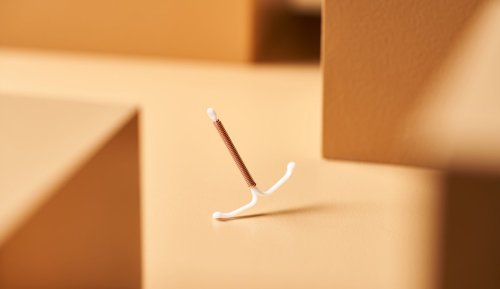What Can You Expect During an IUD Removal, According to an OB/GYN
While there’s plenty about what to expect when your IUD is placed, no many talk about IUD removal. OB/GYNs break it down.

Intrauterine devices, or IUDs, are a popular form of long-acting reversible contraception. More specifically, it’s a small (often t-shaped) device that’s inserted into a uterus to help prevent pregnancy for years. IUDs are known for being a reliable, reversible, and long-lasting form of birth control—but they’re not designed to last forever. At some point, you’ll either need or want to have your IUD removed.
Experts in This Article
board-certified OB/GYN at Orlando Health Winnie Palmer Hospital
nationally-renowned women’s health expert, author, and radio host
There’s plenty of information out there about what to expect during insertion, but we talk about removal way less often. Below, OB/GYNs discuss some of the common changes you might expect.
Why do people decide to remove their IUDs
IUDs can be divided into two different groups: copper IUDs and hormonal IUDs. The copper IUD, known as Paraguard, can protect against pregnancy for up to 12 years. Hormonal IUDs include Mirena, Kyleena, Liletta, and Skyla and they have varying durations. Mirena and Liletta work for up to seven years, according to Planned Parenthood. Kyleena works for five years and Skyla can be used for three years, Planned Parenthood explains.
So why do people remove them? It depends. Christine Greves, MD, a board-certified OB/GYN at the Winnie Palmer Hospital for Women and Babies, says that people will typically decide to have an IUD removed for a few reasons:
- They hope to conceive
- It’s expired
- They feel they don’t need it anymore
- They’re having pain or discomfort
- They have a concern about bleeding
- They don’t like the IUD
What does it feel like to have your IUD removed
IUD insertion can feel a little uncomfortable, but experts say the removal isn’t as bad. Most people experience very little discomfort, says Jennifer Wider, MD, an OB/GYN and women’s health expert. “Sometimes, you can feel mild or moderate cramps as the IUD exits the body, but it doesn’t last long.”
Dr. Greves agrees. “It’s less uncomfortable than the insertion,” she says, adding that patients will “usually just feel a slight cramp.”
What is the actual IUD removal process like
First, you’ll need to make an appointment with your healthcare provider. Once you’re there, your provider will likely counsel you on how long it will take for your fertility to return. They might also ask whether you’re interested in using any other forms of birth control so you can get a new prescription at the same visit, per the American College of Obstetricians and Gynecologists (ACOG).
If you’re planning to conceive, your provider may counsel you on anything you’ll need to do at that point, like taking prenatal vitamins. Then, your provider will likely tell you that mild cramping and a small amount of bleeding are normal after your IUD is removed.
For the actual procedure, you’ll be asked to lie on a table at your doctor’s office, with your underwear and bottoms removed (you’ll usually be given a sheet to drape over you for privacy), Dr. Wider says. Your doctor will place a speculum in your vagina and examine you.
If the strings of your IUD are visible, your doctor will grasp them with forceps or something similar and gently pull on the strings until the entire IUD is removed, ACOG says. Your doctor may give you a heads up before they pull that you could feel a little discomfort and ask you to take a deep breath in advance. The IUD “is designed to fold up as the string is pulled and it will likely slip out without an issue,” Dr. Wider says.
While it’s not common, your doctor may have difficulty removing your IUD or trouble locating it. If that’s the case, they may use a pelvic ultrasound to see where the IUD is in your body. Try not to worry: During checkups and removal procedures, the strings aren’t easily visible to providers four to 18 percent of the time, the ACOG says. If the strings aren’t visible, your doctor may use an instrument called a cytobrush to gently probe your cervix to locate the strings.
In most cases, however, your IUD will come out easily. “Usually getting an IUD out is a fast and easy procedure,” Dr. Wider says.
How will removing your IUD impact your body afterward
In general, you won’t notice many bodily changes after your IUD is removed, Dr. Greves says. “The beautiful thing about the IUD is that it is not systemic,” she says. Meaning, it doesn’t impact your entire body.
However, if you’ve had an IUD that contains progesterone, Dr. Greves says that you may notice your period is a little heavier afterward—simply because the hormone typically makes periods lighter or even non-existent.
As for your fertility, Dr. Greves says it returns “right away,” so it’s best to use another method of birth control if you’re not ready to conceive. If you do hope to conceive, though, Dr. Wider says that you can start trying “immediately” after your IUD is out.
Ultimately, IUD removal is a relatively straightforward process. Still, f you’re considering having your IUD removed and you have questions about how it will impact you, don’t hesitate to reach out to your doctor. They should be able to offer personalized guidance.
Oh hi! You look like someone who loves free workouts, discounts for cutting-edge wellness brands, and exclusive Well+Good content. Sign up for Well+, our online community of wellness insiders, and unlock your rewards instantly.
Sign Up for Our Daily Newsletter
Get all the latest in wellness, trends, food, fitness, beauty, and more delivered right to your inbox.
Got it, you've been added to our email list.










